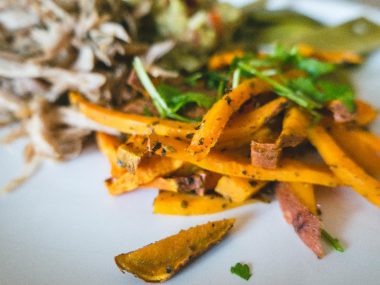Few people would like to eat yesterday’s pasta because it becomes a dry, sticky mass after heating. Pasta with cheese is also a rather ingenious dish: it strives to dry out, then turns into an oily mass – and sometimes both at the same time! However, the situation is not hopeless. Our article will teach you to avoid these problems and heat pasta with cheese so it can be delicious and creamy, just like fresh.
What are the best methods to reheat pasta? There are 4 great methods for pasta with cheese, sauce, or without anything. It’s boiling, using a stove, oven, and microwave oven. In this article, you will find out how to make yesterday’s pasta mouth-watering. Let’s go!
Best Methods To Preheat Pasta
1. Boiling
- Place a pot with water on the stove. Pour enough water to cover the pasta, but don’t add it to the pan. Wait for the water to boil.
- Put the pasta into a colander. The colander should match the volume of the pan. Use a colander with a long handle to make it easier to handle.
- Dip the pasta into boiling water. It will take about thirty seconds to heat the pasta. Remove the pasta colander from the pan and check if it is ready. If they are not ready, place it again into boiling water. Check your pasta every 15 seconds.
You can use other methods outlined in this article, however, this is the fastest and best option if you need to heat pasta without sauce.
2. In the baking oven
- Preheat the oven. Preheat the oven to 347 °F. this is not the best option for one serving.
- Put the pasta in the baking dish. This should be a shallow form. Spread the pasta along the bottom of the mold. If the pasta becomes dry, add some milk or sauce to make it juicy.
- Cover the pasta with the foil and place it in the oven. The pasta will be ready in 20 minutes, but in 15 minutes you can check it for readiness. With this method, your pasta won’t be dry. You can add parmesan to taste, just sprinkle it five minutes before the end of cooking.
- Check if pasta is done. Hold the metal fork in the center of the dish, wait 10 to 15 seconds and if its tip is hot to the touch, the pasta is ready. If not, put the pasta into the oven again.
- Add milk to the pasta with cheese. This will help restore moisture and creamy texture to the sauce.
This method is rather simple and perfect your pasta has some sauce. However, this is not the best option for one serving.
3. On the stove
- Preheat the pasta over medium heat. This is one of the easiest ways to preheat pasta. Add melted butter or vegetable oil to the pan. Put the pasta and stir it. Add more sauce if the pasta is too dry.
- Heat the sauce over low heat. You can find the correct way to do this in the section below.
- Add milk to the pasta with cheese. This will help restore moisture and creamy texture to the sauce.
4. In the microwave oven
- Use a microwave if you need to heat only one serving. In a microwave oven, food is heated unevenly, especially if you heat pasta with cheese or vegetables. If you preheat a large quantity of pasta, do it better in the oven than in the microwave. Do not microwave creamy, wine, and oil sauces.
- Stir pasta with sauce or butter. If you didn’t add the sauce to the pasta during cooking, add some sauce or olive oil, then your pasta won’t be dry.
- Turn on the microwave at medium power. Most likely you will get porridge instead of pasta after turning the oven on at full capacity.
- Cover the pasta. Put the pasta in a container that you can use for the microwave. If possible, use a round container to avoid uneven heating in the corners. Cover the pasta using one of the following methods:
Cover with plastic wrap so that one corner is opened, in that case, pasta warms up more evenly.
Cover the pasta with a damp paper towel and pasta won’t be dry.
Heat pasta using short intervals. Turn on the microwave for 1 minute. Then stir well. If necessary, continue the process for another 15-30 seconds. If your microwave doesn’t have a turntable, turn the dish yourself.
Pasta with cheese.
Pasta continues to absorb moisture after cooking, so the longer the cooked pasta and cheese are stored, the drier they become. The secret to preserving or restoring the texture is to add some milk when heating.
Its quantity depends on the quantity of the product. For example, add 1 tablespoon of milk per 200 g of pasta with cheese and mix. Until the pasta is heated, the milk won’t be completely absorbed, so do not worry that the dish will look a little wet. For a richer texture and taste, the milk can be replaced with light or greasy cream.
Warm-up slowly at medium (50%) power. This will reduce the likelihood that the cheese will “move away” and the pasta will turn out to be slippery and unappetizing. Set the timer to 1 minute for one serving or 90 seconds for more. When time runs out, stir pasta with cheese. Then continue to heat at intervals of 30-60 seconds until the dish reaches the desired temperature.
To season, you can sprinkle pasta with parmesan, salt, and pepper, add a little butter or garlic salt. For a brighter taste, take ketchup, a pinch of cayenne pepper, or some hot sauce. Bon Appetit!
Preheating the sauce
Heat water in a double boiler bowl. This is a good option for sauces like Alfredo. Using this method, you can evenly warm the sauce, which is very important to get the correct consistency. You can make your own double boiler from two pots or from one pot and glass bowl.
If this method does not suit you, you can heat the sauce on the stove over very low heat.
- Place the sauce on top of the double boiler. If possible, heat the sauce separately and then pour cold or warm pasta on it. If the sauce and pasta are already mixed, transfer them to a container. Leave in the container until the water begins to boil. Of course, you can heat pasta with sauce together, but there is a high risk that they stick together and become too soft.
- Add cream or milk to the creamy sauce. If you are using creamy sauce, be prepared for the cream to stratify. Add cream or milk, so your sauce remains uniform and retains the desired consistency.
- Add the butter to the wine sauce. The acid in wine sauce can cause the cream to clot. To avoid this, add a small amount of melted butter. You can use one more option – heat the cream in a separate pan until some of the liquid has evaporated.
- Heat over low heat, stirring occasionally. Since you will heat the cream over low heat, it is unlikely that they will curdle. Stir constantly. Eat while the sauce is hot.
- You can try to add an egg yolk. If you are unable to achieve a uniform sauce consistency, remove the bowl from the heat and pour a couple of tablespoons of the sauce into another bowl. Beat the egg yolk until a mass of uniform consistency is obtained, and then pour the mixture back into the sauce.
If you heat pasta with sauce, don’t use egg yolk. Add a little flour instead to give the sauce the desired consistency.
If you cannot achieve a homogeneous consistency and pieces of boiled egg come across in the sauce, try to repeat the process using less liquid and whisking the egg faster. If small clumps remain, strain it and use the remaining liquid.



